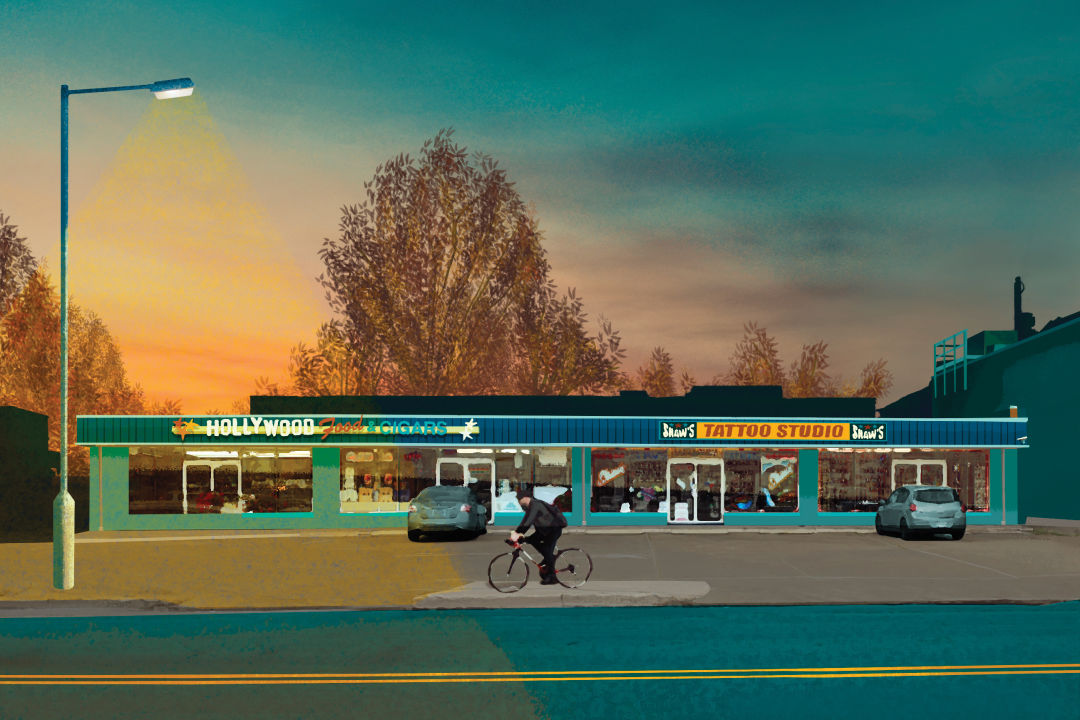In Defense of Houston's Strip Malls

Image: Christopher Vela
The corner where Westheimer coincides with Dunlavy is a lovely one. The clean, glass-and-steel lines of the modernist bakery Common Bond stand gracefully at attention, as pleasing to the eye as the greenery-filled patio of perpetually hip Brasil Cafe across the street. To the west, rows of bungalows-turned-antique-stores and Greek coffee shops stretch toward River Oaks. To the east, a postcard view of Houston emerges. It’s the kind of bustling, bohemian-bourgeoisie district tourism promoters everywhere now tout. But just a few steps down Westheimer, the true Houston reveals itself.
Here, set back from the street, under a plasticky blue awning, squats a strip mall that houses Hollywood Food & Cigars and Shaw’s Tattoo. The oil-stained parking lot has been patched and repatched a thousand times. Thick metal bars decorate the windows behind lettering that reads “Serving Houston Since 1979.” It’s the kind of structure many Houstonians decry when listing the afflictions of their city—traffic, potholes, underfunded pensions, those awful strip malls. But Raj Mankad sees something else.
“It’s pretty dang perfect in my opinion,” says Mankad, the editor of the Rice Design Alliance’s Cite magazine. “The parking lot and the setback of that small strip mall and the intense lighting of the Hollywood convenience store at night all work really beautifully—that one void in an otherwise solid wall of buildings is just right.”
In the Bayou City, defending the ubiquitous strip mall carries the same whiff of insanity as defending giant tree roaches or mosquitoes. Strip malls sprout and sprawl like clumps of salvinia across a humid swamp. Their aesthetic merits are dubious; their environmental impact, baleful. Yet each strip mall—with its nail salons and pho joints, its coffee shops and dry cleaners—is a miniature land of opportunity for its tenants. One might even argue that there’s no purer distillation of Houston itself.
“They’re so common in Houston, they make up so much of the city. But they get very little attention,” says Mankad. “The older ones especially are often home to the kind of diversity that we celebrate so much in Houston—that’s where it happens.” He cites as a favorite example the jumble of strip centers at Hillcroft and Harwin, which have been repurposed over the years into the now-bustling Mahatma Gandhi District.
Here, mixed in among the sari shops and jewelry stores and chaat houses, are “three or four Hindu temples, a mosque, at least one evangelical church, a tailor, an ambulance dispatcher, an eyebrow threader,” Mankad lists gleefully. “Then there’s high schools and strip clubs and hotels and bus stations where you can get on and off a bus to Mexico, and all in a really compact area—and it’s all strip malls! That, in my opinion, is where it’s at—where we have the actual mix of uses and vitality that we used to associate with main streets.”
It’s an association not far removed from the original intent behind strip malls—which, as it happens, is not developer Ed Wulfe’s preferred nomenclature. “They’re neighborhood centers,” emphasizes the man who created two of Houston’s first such developments: Gulfgate Center and Meyerland Plaza, both of which opened in 1957.
After World War II, when many Houstonians were moving to suburbs like those springing up near Gulfgate and Meyerland, the city itself was busy refashioning itself as a modern metropolis built around the car. Centers like these were the ideal retail solution, bringing that downtown Main Street energy to newly residential areas.
Wulfe sees them serving the same purpose today, though they’re usually smaller, the better to squeeze into an increasingly built-up city. Today there’s now an estimated 25,000 neighborhood centers across Houston, most of them 20,000 square feet or less. “They’re filling a void of getting a whole lot of kinds of retailers right in the heart of where the people are,” he says.

Kaiser Lashkari's popular restaurant, Himalaya, is housed in a strip mall off 59.
Image: Monica Fuentes
In 2004, Kaiser Lashkari, whose nigh-legendary restaurant Himalaya is one of many lauded Houston eateries stashed in a strip mall, made the choice to open in the Spanish-tiled, Desi-populated Olympic Center that sits at Highway 59 and Hillcroft for that very reason. “You attract a lot of reciprocal business,” he says, “like if somebody comes to buy groceries and they want a bite to eat, or if somebody comes here to pick up a video or DVD next door, they will buy something to eat to take home.”
Still, he’s quick to admit there are distinct disadvantages to doing business in a strip center, where management can neglect the upkeep of the common areas, where parking can be tight, and where your neighbors can pull you down as quickly as they can buoy you. “If two or three businesses are not doing well, then reciprocally your business will also suffer.”
Lashkari sees the benefits to the laissez-faire, take-all-comers attitude posed by the humble, unimposing strip mall. “Here, we get people from all cross-sections of society, even people from River Oaks, and all of them come here for the food,” he says. “They don’t care whether this is in a shopping center, whether it’s a very prestigious place or not.”
Yet, asked whether he’d consider forsaking his strip-center roots for a freestanding spot of his very own one day, Lashkari—ever the Houstonian, never looking back, always forward—laughs. “I would leave in a New York minute.”




